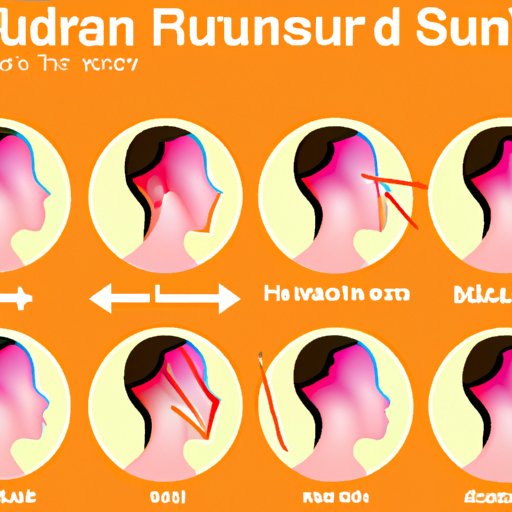Introduction
It’s no secret that the sun’s ultraviolet (UV) rays pose a significant threat to our skin. Whether the sunburn is mild or severe, the pain and discomfort caused by this overexposure are undeniable. What most people don’t know, however, is that the damage doesn’t end there. In this article, we’ll discuss how long it takes for sunburn to heal, as well as preventative measures you can take to protect your skin from long-term damage.
The Science of Sunburn: Understanding the Healing Process
Before we dive into the healing process, let’s review what causes sunburn in the first place. When our skin is exposed to UV radiation, it causes damage to the DNA in our skin cells. This triggers an immune response, resulting in inflammation, which presents as redness, swelling, and pain.
Once this happens, our body kicks into gear to heal the damaged skin. The healing process can vary depending on the severity of the burn. Mild sunburns usually heal within three to five days, but more severe burns may take up to two weeks or longer.
Speeding Up the Healing Process: Tips and Remedies for Sunburn Relief
If you’re looking to ease the pain and speed up the healing process, there are several remedies you can try:
Home Remedies
- Cool compresses or a cold bath
- Aloe vera gel or honey as a natural antibacterial agent
- Hydrating with water and moisturizing with a fragrance-free lotion
Over-The-Counter Treatments
- Ibuprofen or aspirin for pain relief and reducing inflammation
- Hydrocortisone or lidocaine creams to relieve itching and inflammation
- Vinegar diluted in water to alleviate pain and discomfort
Expert-Recommended Solutions
- Oatmeal or baking soda baths to relieve itchiness and inflammation
- Topical vitamin C and E creams to promote collagen production and boost skin health
- Prescription-grade ointments or steroids for severe burns
The Importance of Preventing Sunburn: Protecting Yourself from Painful Burns and Long-term Damage
While it may be tempting to soak up the sun for a golden tan, it’s essential to prioritize your skin’s health and protect yourself from the sun’s harmful rays. Here’s why:
Significance of Protecting Your Skin from Sun Damage
- Reducing the risk of skin cancer and pre-cancerous skin lesions
- Minimizing signs of aging and maintaining a youthful appearance
- Preventing sun-induced eye damage, including cataracts and macular degeneration
Benefits of Sunscreens
- Avoiding burns and skin damage
- Reducing the risk of skin cancer
- Maintaining an even skin tone and preventing premature aging
Long-term Effects of Repeated Sunburns on the Skin
- Prolonged damage to the skin, speed up skin aging, cause scarring, and pigmentation
- Weakened immune system and increased vulnerability to skin infections
- Increased risk of developing skin cancer, such as melanoma, basal, and squamous cell carcinomas
Understand Your Skin’s Susceptibility: Factors Affecting Sunburn Healing Time
Several factors can influence how long it takes for sunburn to heal:
Skin Type
Pale skin is more likely to burn than darker skin tones due to lower melanin concentration, which decreases the skin’s ability to protect against UV radiation. Darker skin types may still burn, but it takes longer exposure time.
Age
As we age, our skin loses elasticity and thickness, which can increase the sensitivity to sun exposure. Therefore, older adults may take longer to heal from sunburns than younger individuals.
Severity of Burn
The deeper and more extensive the burn, the longer it takes for the skin to heal. sunburn that blisters is categorized as moderate to severe burn and can take up to two weeks to heal fully.
Sunburn or Skin Cancer? Knowing the Signs and Seeking Medical Help
While most sunburns can be treated at home, it’s essential to know when you need to seek medical attention. Here are some signs and symptoms to watch out for:
Signs and Symptoms of Sunburn vs. Skin Cancer
Sunburn and skin cancer have similar symptoms like red, irritated skin that becomes painful, blisters or open sores. However, with a sunburn, the symptoms gradually improve with at-home care, whereas skin cancer symptoms progress and worsen over time, becoming more painful and eventually spreading to other parts of the body.
When to Seek Medical Attention for Sunburn
If you experience severe swelling, accompanied by blisters and fever or chills, you may need medical attention to prevent infection and ensure proper healing. Those with a history of melanoma or other skin cancers should exercise extra caution and consult with a dermatologist about proper sun protection methods.
When to Treat Sunburn at Home
If your sunburn is mild and doesn’t worsen, treating it at home may be effective. By following the healing remedies and taking proper sun protection measures, your sunburn should heal within a week.
The Aftermath of Sunburn: Caring for Your Skin Post-Healing
Even after your sunburn has healed, it’s crucial to care for your skin to prevent further damage. Here are some tips to restore your skin to its healthy glow:
Long-term Effects of Sunburn on the Skin
- Promotes dryness and flakiness
- Encourages wrinkles and fine lines
- Causes uneven pigmentation and sunspots
Suggestions for Products and Routines
- Using gentle, hydrating skincare products to promote moisture and restore skin vitality
- Regularly exfoliating to remove dead skin cells and encourage cell turnover
- Taking vitamins C and E to promote collagen production and boost skin health
Conclusion
Now that you understand how long it takes for sunburn to heal, you can take preventative measures to protect your skin from UV radiation. Remember to always wear sunscreen, protective clothing, and to avoid spending too much time in the sun during peak hours. Additionally, if you do suffer from sunburn, following the remedies and tips we’ve discussed can help aid the healing process and prevent long-term damage.
